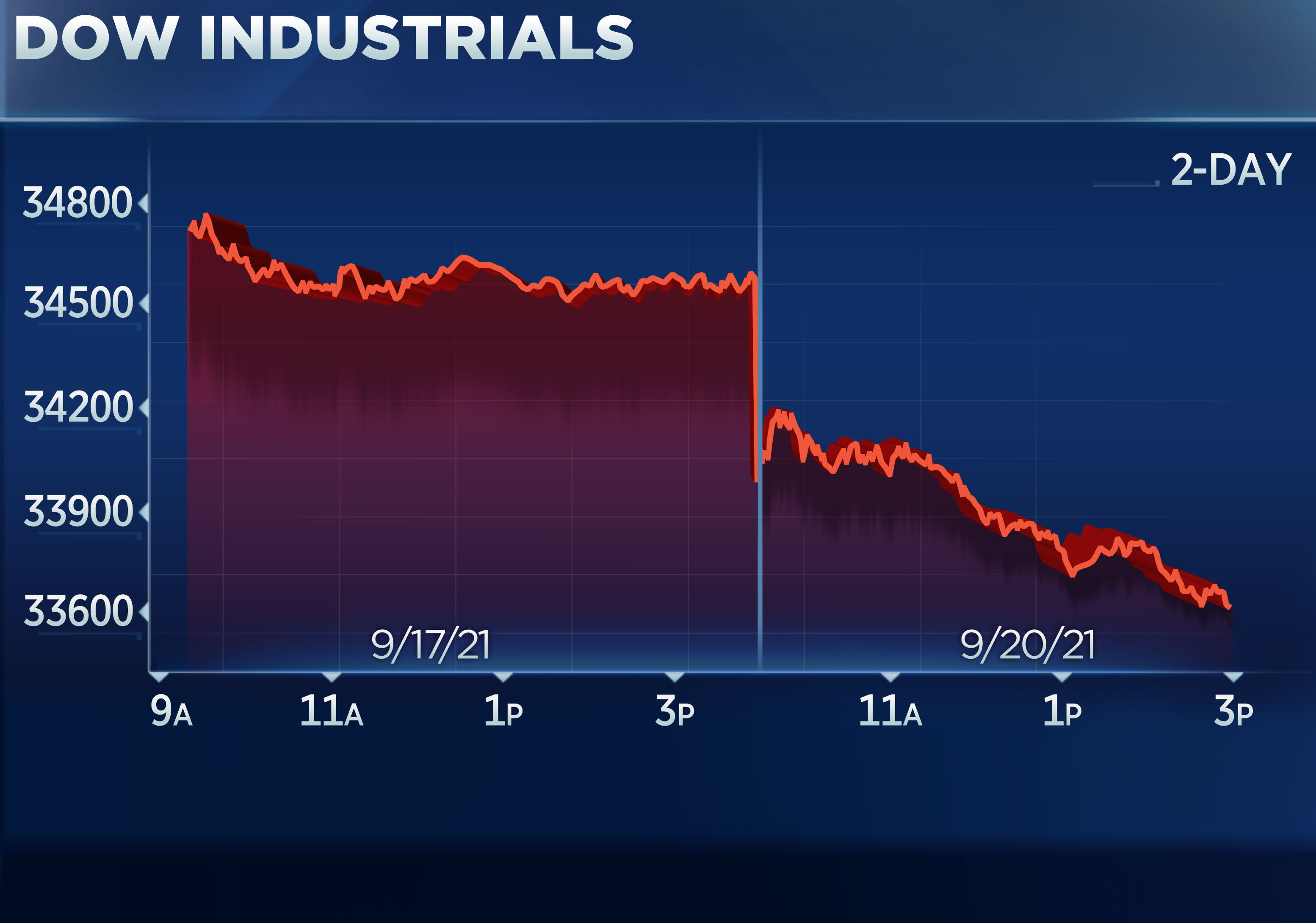
U.S. stocks began the week deeply in the red as investors continued to flock to the sidelines in September amid several emerging risks for the market.
The Dow Jones Industrial average lost 950 points, or 2.8%, set for its biggest one day drop since October 28, 2020. The S&P 500 fell 2.8%, also on pace for its worst daily performance in nearly 11 months. The tech-heavy Nasdaq Composite dropped 3.4%.
There were a number of reasons for the sell-off:
- Investors fear a contagion sweeping financial markets from the troubled China property market. Hong Kong equities saw a big sell-off during the Asia trading session on Monday. The benchmark Hang Seng index plunged 4% with embattled developer China Evergrande Group on the brink of default.
- The Federal Reserve begins a two-day meeting Tuesday and investors are worried the central bank will signal it’s ready to start pulling away monetary stimulus amid surging inflation and improvement in the job market.
- Covid cases because of the delta variant remain at January levels as colder weather approaches in North America.
- September has the worst track record of any month, averaging a 0.4% decline, according to the Stock Trader’s Almanac. History shows the selling tends to pick up in the back half of the month.
- Investors are also concerned about brinkmanship in DC as the deadline to raise the debt ceiling approaches. Congress returned to Washington from recess rushing to pass funding bills to avoid a government shutdown.
Monday’s sell-off pushed the S&P 500 5% below its last record on an intraday basis. It’s been a long time since the market has faced a sell-off of this magnitude as investors continued to buy the dip with fiscal and monetary stimulus backstopping the markets. If it was to reach the 5% pullback on a closing basis, it would be the first such decline for the equity benchmark since October 2020, according to LPL Financial Research. The blue-chip Dow and the Nasdaq are down more than 5% from their respective record highs on an intraday basis.
Stocks linked to global growth were down the most Monday. Ford and Carrier Global lost more than 3%. General Motors and Boeing fell about 2% each. Nucor steel shed 2.8%
Energy stocks tumbled as WTI crude oil fell 2% on concerns about the global economy. The energy sector fell 3.3%, becoming the worst-performing group among the 11 S&P 500 groups. APA shed more than 6%, while Occidental Petroleum and Devon Energy both dropped over 5%. Hess also lost 5.3%.
Bond prices gained as investors sought safety. The move pushed the 10-year Treasury yield down by 5 basis points to 1.325%.
Big bank stocks took a hit as the falling rates may crimp profits. Bank of America and JPMorgan Chase were each down more than 2%.
“We think the mid-cycle transition will end with the rolling correction finally hitting the S&P 500,” wrote Mike Wilson, Morgan Stanley’s chief U.S. equity strategist. “We point to downside risk to earnings revisions, consumer confidence and PMIs.”
Wilson said he believes a “destructive outcome” is looking more likely that results in a pullback of 20% or more. On Friday, University of Michigan’s September consumer sentiment index came in at 71, just slightly above the August level that was the lowest in 9 years.
The Cboe Volatility index, Wall Street’s fear gauge, jumped above the 26 level on Monday, the highest since May.
“We are in an information vacuum at the moment,” said Jamie Cox, managing partner at Harris Financial Group. “Stalemates in Congress on the debt ceiling, worries on policy changes or mistakes in monetary policy, and a litany of proposed tax increases have dampened the mood for investors. When this occurs, corrections happen.”
Stocks have struggled so far in September in line with historical trends. For the month, the Dow is off 3.3%. The S&P 500 is lower by 3.2% and the Nasdaq Composite is lower by 2.9%.
On Friday, the Dow Jones Industrial Average turned in three straight weeks of losses for the first time since September 2020. The S&P 500 saw its biggest trading volume Friday since July 19, more than doubling its 30-day average volume.
Friday coincided with the expiration of stock options, index options, stock futures and index futures — a quarterly event known as “quadruple witching.” History shows volatility tends to pick up around this event.
Fed Chair Jerome Powell will hold a press conference Wednesday at the conclusion of the two-day meeting. Powell has said the so-called tapering could occur this year, but investors are waiting for more specifics, particularly after mixed economic data released since Powell’s last comments.
Some investors believe this is just normal market action that can occur in September.
“The reasons for drop this morning are the same as last week: China concerns (Evergrande, regulation, COVID), Fed tapering and possible tax hikes, but nothing new occurred this weekend to justify this mornings’ declines,” Tom Essaye, founder of Sevens Report, said in a note.
Other risky assets declined on Monday. Bitcoin lost as much as 10% to below $43,000.
Most commodities were in the red. Gold was among the few assets in the green, adding 0.5% to $1,760.
— With assistance from CNBC’s Nate Rattner




